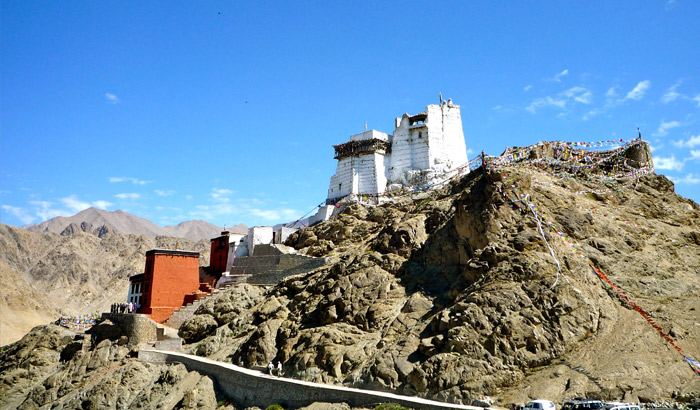High in the Himalayan ranges, two significant Buddhist monasteries, Namgyal Monastery and Namgyal Tsemo Monastery, serve as spiritual havens for both monks and travelers. Steeped in Tibetan Buddhist tradition, these monasteries offer insight into centuries-old spiritual practices, architectural marvels, and serene environments that take you beyond the realm of ordinary tourism. Whether you’re seeking a connection with your inner self or simply curious about Tibetan culture, these two monasteries promise a journey that touches both heart and soul.
Namgyal Monastery: The Dalai Lama's Personal Monastery
What is Namgyal Monastery?
Nestled in Dharamshala, India, Namgyal Monastery is the personal monastery of the Dalai Lama, making it one of the most important religious institutions in Tibetan Buddhism. Originally established in Tibet in 1564 by the second Dalai Lama, Namgyal Monastery was relocated to India after the Chinese occupation of Tibet in 1959. Today, it serves as a center for the Dalai Lama’s religious activities and a hub of spiritual learning.
The Role of Namgyal Monastery in Tibetan Buddhism
Namgyal Monastery holds a unique position in the spiritual world of Tibetan Buddhism. It’s not only a place of worship but also a learning center for monks who practice ritual arts, meditation, and philosophical studies. The monastery performs key religious ceremonies and rituals that support the Dalai Lama’s role as the spiritual leader of Tibetan Buddhists.
Architecture and Structure
The Unique Layout of Namgyal Monastery
The architecture of Namgyal Monastery is a harmonious blend of traditional Tibetan elements and modern influences. Its layout is designed to facilitate various spiritual practices, including meditation halls, temples, and libraries. The peaceful surroundings allow for deep introspection and spiritual awakening.
Spiritual Practices at Namgyal Monastery
Daily life at Namgyal Monastery revolves around spiritual rituals such as prayers, meditation, and teachings from Buddhist scriptures. These practices are an integral part of the monk’s daily routine and offer visitors a glimpse into the monastery's rich spiritual traditions.
Namgyal Tsemo Monastery: The Jewel of Ladakh
Introduction to Namgyal Tsemo Monastery
Situated high above the city of Leh in Ladakh, Namgyal Tsemo Monastery stands as a beacon of spiritual tranquility amidst the rugged beauty of the Himalayas. Founded in the early 15th century by King Tashi Namgyal, this monastery is famed for its awe-inspiring three-story Buddha statue and stunning panoramic views of Leh and the surrounding valleys.
The Spiritual Significance of Namgyal Tsemo
Namgyal Tsemo Monastery holds a vital place in the spiritual life of Ladakh. Its serene ambiance and the sacred aura of the giant Buddha statue create an environment that fosters meditation and introspection. Pilgrims and tourists alike come here seeking spiritual solace and a deeper connection with Buddhist teachings.
Architectural Grandeur of Namgyal Tsemo
The Iconic Three-Story Buddha Statue
The centerpiece of Namgyal Tsemo Monastery is undoubtedly the towering three-story statue of Maitreya Buddha, which stands as a symbol of compassion and enlightenment. Carved from clay and adorned with gold, this statue is a magnificent representation of Buddhist artistry.
The Monastery's Strategic Location
Perched on a hilltop, the location of Namgyal Tsemo Monastery offers breathtaking views of Leh and the Zanskar range. The serenity of the surroundings combined with the monastery’s elevation creates a perfect environment for meditation and spiritual practice.
Namgyal Tsemo's Role in Ladakhi Culture
Religious Festivals and Rituals
Namgyal Tsemo Monastery is at the heart of many religious festivals in Ladakh. One of the most important is the Tsemo Nagrang festival, where monks perform sacred dances and rituals to honor deities and ensure prosperity for the region.
Influence on Local Communities
Over the centuries, Namgyal Tsemo Monastery has shaped the cultural and spiritual practices of the people of Ladakh. The monastery plays a pivotal role in preserving Ladakh’s Buddhist traditions, and its influence can be seen in local art, festivals, and daily life.
Comparing Namgyal Monastery and Namgyal Tsemo Monastery
Similarities in Spiritual Practices
Both Namgyal Monastery and Namgyal Tsemo Monastery follow Tibetan Buddhist traditions, with daily rituals, meditations, and teachings from Buddhist scriptures forming the backbone of their spiritual practices.
Differences in Location and Architecture
While Namgyal Monastery in Dharamshala is situated amidst lush greenery, Namgyal Tsemo Monastery’s location in Ladakh offers stark, rugged beauty. Architecturally, Namgyal Monastery incorporates a blend of traditional and modern designs, whereas Namgyal Tsemo remains steeped in the ancient style of Ladakhi monasteries.
Travel Guide to Namgyal Monastery
Best Time to Visit Namgyal Monastery
The best time to visit Namgyal Monastery is between March and June when the weather in Dharamshala is pleasant and ideal for exploring the surrounding areas.
How to Get There
Namgyal Monastery is easily accessible from Dharamshala, a popular tourist destination in Himachal Pradesh. The nearest airport is Gaggal, and from there, you can take a taxi or bus to the monastery.






Comments